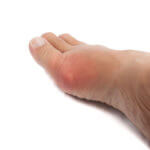 A hernia is a condition that develops when fatty tissue or an organ pushes through a fascia, a weak spot in the connective tissue or muscle that surrounds the organ or fatty tissue. It is a common condition that requires a medical diagnosis. Not all hernias require medical intervention; however, many do, and if they progress without being treated, a dangerous situation could arise.
A hernia is a condition that develops when fatty tissue or an organ pushes through a fascia, a weak spot in the connective tissue or muscle that surrounds the organ or fatty tissue. It is a common condition that requires a medical diagnosis. Not all hernias require medical intervention; however, many do, and if they progress without being treated, a dangerous situation could arise.
Do you suspect that you have a hernia? If so, here’s a more in-depth look at the types of hernias, the most common symptoms, and what to do if you think you have one.
Types of Hernias
There are several types of hernias, and all of them affect the body in a different way. In order to determine if you do have a hernia, you first need to understand the difference between each type so that you can accurately pinpoint the signs and symptoms.
Inguinal Hernias
The inguinal hernia is the most common type of hernia, representing an estimated two-thirds of the hernias that are experienced in adults. They are more common in men than in women, though women can still develop one.
This type of hernia develops when an organ, such as the intestine, or tissue, protrudes through a weak spot in the muscles of the abdomen, or in the inguinal canal, the part of the groin where the testicles descend in men prior to birth. The protrusion causes a bulge, which can be painful, particularly when lifting something heaving, bending over or coughing. An inguinal hernia does not improve on its own. It is not always dangerous; however, it can lead to complications that are life-threatening.
Causes of an inguinal hernia vary. In some people, they develop for no particular reason, though in others, they can develop as a result of the following:
– A weak spot in the wall of the abdomen
– An increased amount of pressure in the abdomen
– Straining while passing bowel movements or urinating
– Lifting excessively heavy items
– Pregnancy
– Coughing or sneezing with excessive force
There are certain risk factors that can increase the chances of developing an inguinal hernia. These risk factors include:
– Being a male
– Being older, as the muscles in the abdomen tend to weaken with age
– Being caucasian
– Having a family history of inguinal hernias
– Chronic coughing that increases the amount of pressure on the abdomen
– Chronic constipation, which can increase the amount of pressure placed on the abdomen
– Being pregnant, as pregnancy can weaken the abdominal muscles, leading to increase pressure in the abdomen
Umbilical Hernias
As the name implies, this type of hernia forms in the area where a person’s umbilical cord was located. During pregnancy, a woman and fetus are connected via the umbilical cord, which passes through a small opening in the muscles of the stomach. Usually, this opening closes after birth; however, when it doesn’t close, the intestines or tissue can protrude through the opening around the belly button.
Umbilical hernias usually affect children and often clear up on their own by the age of four. Babies who are born premature or who have a low birth weight are more likely to develop this condition. Adults can also develop this type of hernia when too much pressure is placed on the weakened portion of the abdomen.
Risk factors for developing an umbilical hernia include:
– Being overweight
– Pregnancy, especially multiple pregnancies
– The development of fluid in the abdominal cavity
– Surgery on the stomach
– A heavy, persistent cough
In children, umbilical hernias rarely cause complications; but problems can occur in both children and adults, especially if the hernia is incarcerated. Surgery isn’t always recommended, especially for children; however, if the hernia does not clear up on its own, or if an adult develops the condition, surgery may be necessary to prevent any future complications.
Incisional Hernias
Also known as a ventral hernia, this type of hernia also occurs when there is a weakness in the abdominal muscles. As a result of this weakness, tissue from the abdomen can push through the muscle, causing a bulge to appear under the skin. The weakened muscles in the abdomen are the result of abdominal surgery; the muscles in the abdomen are cut during surgery, and if they don’t heal, a gap can open as the muscles are tightened and flexed. Over time, the underlying tissues can escape through the gap in the muscles, which is when an incisional hernia develops. In most cases, only a small amount of the abdominal lining pushes through the gap; however, in serious cases, parts of the organs can move through the gap.
There are factors that can increase the risk of developing an incisional hernia, and these factors include:
– Multiple abdominal surgeries. Each surgery requires a new incision, which weakens the wall of the abdomen and increases the risk for developing the gap that causes a hernia to develop.
– Significant weight gain after abdominal surgery.
– Pregnancy after abdominal surgery.
– Activities that increase the pressure on the abdomen after surgery, such as heavy lifting.
Hiatal Hernias
This type of hernia affects the diaphragm, which makes it different from other types of hernias, which affect the abdomen or the groin. The hiatus is the opening in the diaphragm, the wall that separates the abdomen from the chest cavity. Typically, the esophagus extends through the hiatus and attaches to the stomach. When a hiatal hernia forms, the stomach pushes up into the chest through the opening.
There are two types of Hiatal hernias:
Sliding – The stomach and the portion of the esophagus that connects to the stomach move up into the chest via the hiatus. This is the more common type of hiatal hernia.
Paraesophageal – This is less common but more dangerous. Part of the stomach pushes through the hiatus and positions itself next to the esophagus. There is a risk that the stomach will become strangulated with this type of hiatal hernia.
The cause of a hiatal hernia is unknown; a person may be born with a larger opening in the hiatus, or increased pressure on the area could cause the hernia to develop. Risk factors for developing this type of hernia include:
– Being a woman
– Being over age 50
– Being overweight
– Pregnancy
– Excessive strain
– Heavy lifting
Femoral Hernias
This is the least common type of hernia, accounting for less than 5 percent of all hernias. They are more common in women, but men can also develop this type of hernia. Developing in the groin, a femoral hernia occurs when there is a weakness in the lower portion of the groin, which allows for part of the intestine to push through the femoral canal, an area near the femoral vein that transports blood from the leg.
Though the exact cause of a femoral hernia is not known, it is suspected to be the result of any of the following:
– Being born with a weakened spot in the femoral canal.
– Weakness that develops in the femoral canal overtime.
– Childbirth
– Chronic constipation
– Being overweight
– Heavy lifting
– Chronic coughing and sneezing
Though they are the least common type of hernia, they are also the most dangerous, as they are more likely to develop strangulation or incarceration. As a result, once a femoral hernia is diagnosed, surgical repair is often advised to prevent dangerous complications from occurring.


